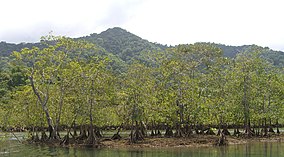Utría National Natural Park
| Utría National Natural Park | |
|---|---|
| Parque Nacional Natural Utría | |
|
IUCN category II (national park)
|
|

Mangroves along the shore of the park
|
|
| Location | Chocó Department, Colombia |
| Nearest city | Tribugá |
| Coordinates | 6°00′11″N 77°14′31″W / 6.003°N 77.242°WCoordinates: 6°00′11″N 77°14′31″W / 6.003°N 77.242°W |
| Area | 54,300 ha (210 sq mi) |
| Designation | National park |
| Created | October 1987 |
| Administrator | SINAP |
The Utría National Natural Park (Spanish: Parque Nacional Natural Ensenada de Utría) is a national park in the Chocó Department, Colombia. It contains diverse flora and fauna in a lush, mountainous rainforest environment with some of the highest rainfall in the world, at up to 10,000 millimetres (390 in) annually. The park also protects the coastal marine environment, and is known for visits by humpback whales, who give birth in the lagoon after which the park is named, and sea turtles who nest on the beaches. There is accommodation for visitors, and ecotourism services are provided by the local indigenous people and members of the coastal Afro-Colombian communities.
The Utría National Natural Park is on the Pacific coast of Colombia in the Chocó Department. It covers parts of the municipalities of Bahía Solano, Nuquí, Bojayá and Alto Baudó. The park overlaps the territory of the Emberá indigenous people, who have well-preserved cultural traditions. There are also fishing villages of Afro-Colombian people along the coast. Both groups are strongly oriented towards conservation of the environment.
The park is north of the Gulf of Tribugá. It is named for the Ensenada de Utría (Utría Cove), a huge seawater lagoon at the northwest entrance of the park surrounded by grey beaches and mangroves. The park was created in 1987. It has an area of 54,380 hectares (134,400 acres) including the protected marine and land areas. Elevations range from 0 to 1,400 metres (0 to 4,593 ft) above sea level. The park covers part of the Baudó mountains. The Condoto, Condotico and Valle rivers and the Mundúquera stream originate in the park.
The climate is warm and humid, with mean temperatures from 23 to 30 °C (73 to 86 °F). The average annual temperature at sea level is 28 °C (82 °F). The park is in a region of Chocó that is one of the wettest areas of the world, with rainfall of up to 10,000 millimetres (390 in) annually. There is rain on over 300 days each year, with most rain in October and least rain in February.
There are coral reefs along the shore that contain 11 of the 16 species of coral recorded in the Pacific region, including branched corals of the Pocillopora and Porites genera, Psammocora stellata, three species of the genus Pavona and Gardineroseris planulata. About 81 species of mollusks have been reported, including Eastern Pacific giant conch (Lobatus galeatus) and ark clams of the Anadara genus which provide food to the local communities. There are over 180 species of fish ranging from tiny goby fish to the huge whale shark (Rhincodon typus).
...
Wikipedia

